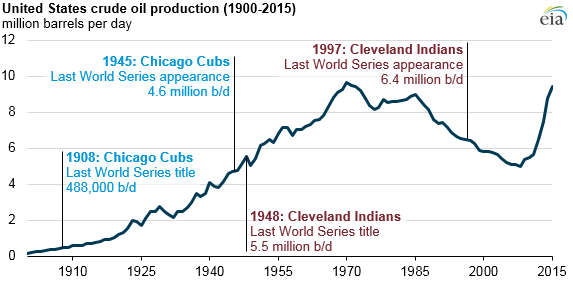Yesterday the U.S. Energy Information Administration’s Today in Energy had a special baseball themed topic: energy production and the 2o16 Major League Baseball World Series.
So let’s take a look at energy production and our two teams the Cleveland Indians and the Chicago Cubs.
As quoted from Today in Energy: “In the 68 years since the last title for the Cleveland Indians, and the 108 years since the last World Series title for the Chicago Cubs, energy production and consumption patterns in the United States have changed a great deal. In 1908, the last time the Cubs won the World Series, the United States produced less than half a million barrels per day (b/d) of oil, with crude oil production having only started approximately 50 years earlier. At that time, crude oil was mainly refined to produce kerosene for use in lamps. The first Ford Model T automobile was produced in 1908, kicking off a shift in demand for petroleum products from kerosene for lamps to gasoline for automobiles. The last time the Cleveland Indians won the World Series, in 1948, the United States produced 5.5 million b/d of crude oil. Crude oil production had been steadily increasing since declines in the 1930s and would continue to increase until production declines in the 1970s.”
As many of us are aware, the consumption of energy has significantly changed over the past century. Going back to 1908, the U.S. only consumed 15 quadrillion British thermal units (Btu) with the majority, three quarters, coming from coal. Fast forward to the last time the Cubbies made their World Series appearance in 1945, total energy consumption had doubled (4.5 million b/d); although coal was still the leading fuel followed by petroleum.
The last World Series appearance for the Indians was in 1997. By then energy consumption had increased to numbers close to those seen today at 6.4 million b/d, or 94 quadrillion Btu. Yet a major change was that coal was no longer king with its share falling to one-quarter of total consumption while natural gas and nuclear held the top spots. For the past two decades, natural gas consumption has continued to increase and there has been rise in renewables.


